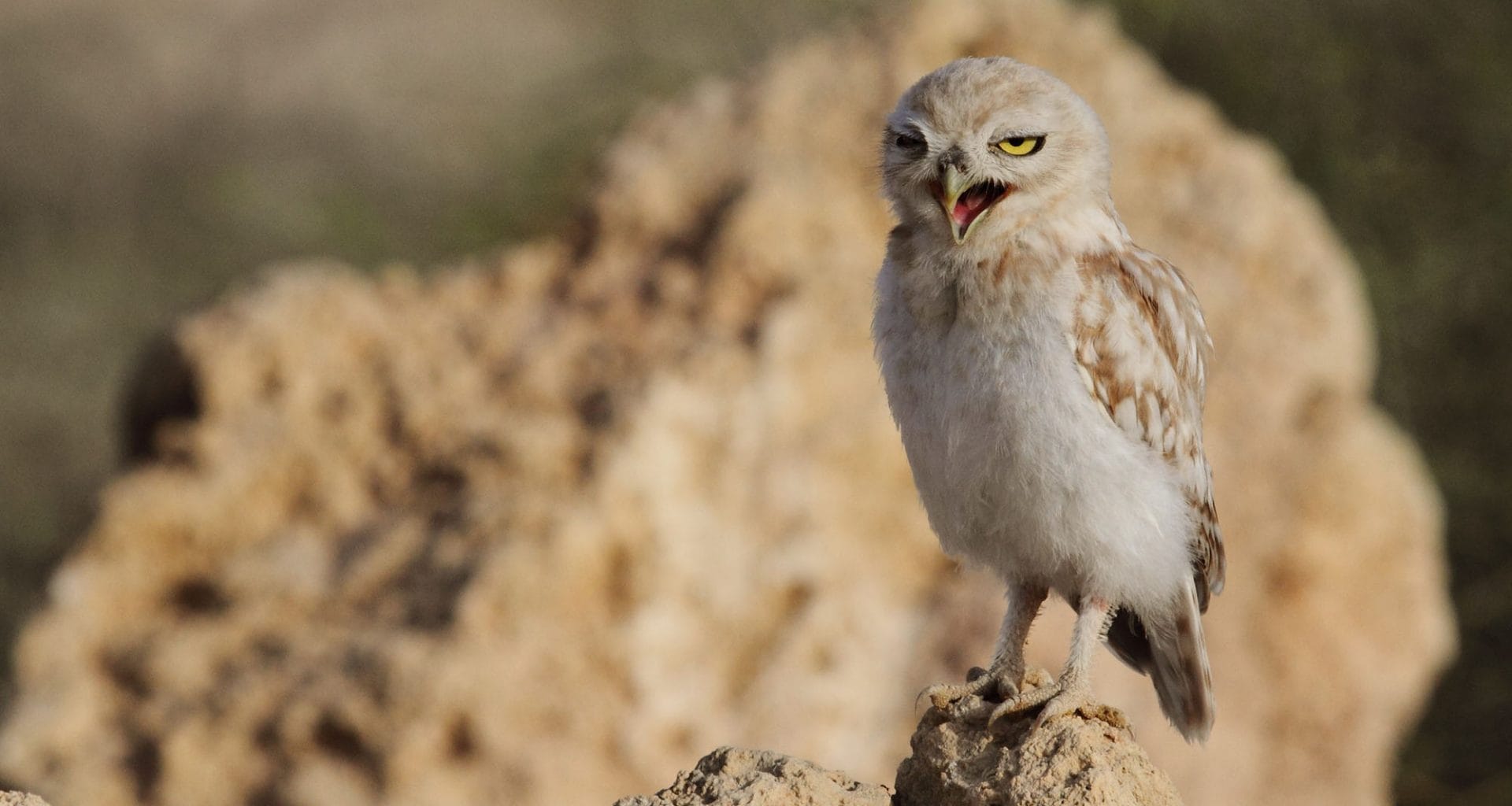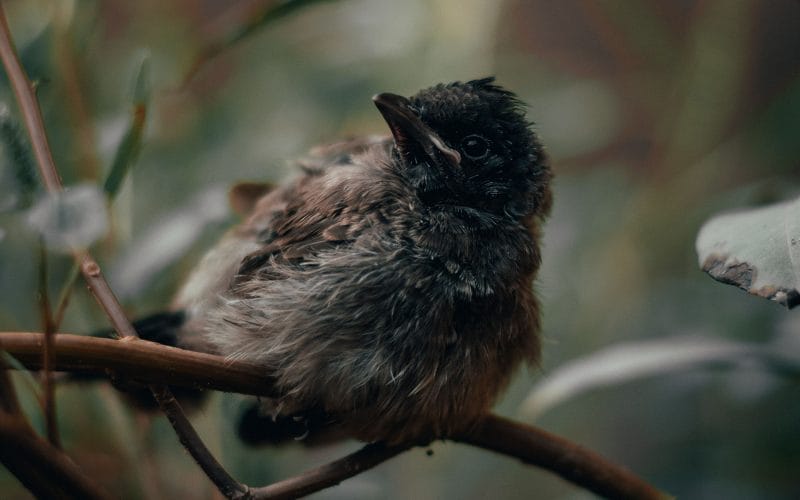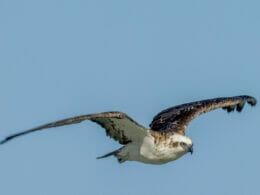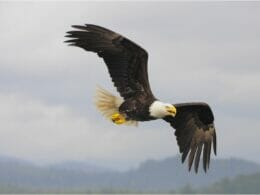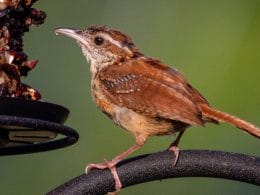Birds have the weirdest sleeping habits out of living creatures. For instance, they don’t go into a deep slumber like humans, and most animals do. Instead, they go into slow-wave sleep, keeping their senses alert to protect them against any potential danger.Another note-worthy sleeping habit of birds is that they sleep standing up.
Strangely enough, it makes them more comfortable than laying down as we do. It’s partially due to the slow-wave slumber they go into; standing up keeps them half-conscious so that they can respond to any pouncing predator.
Do Birds Sleep Standing Up? And Why?
Birds do stand up, but not all of them. It depends on the species; most birds that sleep standing up are those living in the wild, where the danger is typically greater. The standing position keeps the birds’ muscles up and ready to fly. Plus, it helps them stay alert without going into a deep sleep, which can cause their death if a predator strikes.
Some birds also sleep standing up because that’s the only way they can get comfortable. For instance, flamingoes mostly live in caustic salt falls. There’s nowhere they can sit or lie around, so they must sleep standing up.
Why Do Some Birds Sleep Standing up on One Leg?

If you’ve seen flamingos before, you probably know they sleep standing up on one leg. They’re not the only species to do so; it’s a common occurrence among mallards, geese, and hawks, as well.
It’s a pretty odd way to nap; the position can’t possibly be comfortable, especially with birds that have long legs. Right?
Well, birds have some weird ways to make themselves comfortable, but they sleep on one leg primarily for balance, not for comfort. Believe it or not, birds like flamingos have better balance when they have only one leg propped up. The sway significantly decreases, making them at less risk of falling down.
If you want an anatomical explanation, the odd position is mainly due to the birds’ thighs. Unlike humans’ thigh bones, those of birds are oriented in a horizontal position. As a result, the birds’ bones look like they’re doing the chair pose.
Author Note: Standing up on one leg locks the joints in place, which keeps the knee from flexing. At the same time, the joint stays fully extended, providing enough comfort for the birds to sleep.
Not only that, but these birds also exert much less effort standing up on one leg than using both. So, the position is actually more comfortable for them.
Simply, flamingoes and similar birds only sleep in that position because it needs less energy to keep them propped up. Some of them also do it to keep themselves warm by tucking their legs into their feathers.
How Do Different Bird Species Sleep?
Scientists estimate the number of bird species in the world to be around 10,000 species. It’s only natural that they find different ways to sleep, especially when some of them have very different anatomies.
There are multiple different positions birds can sleep in. Here’s a roundup of the most common positions.
Floating on the Water
If you visit duck ponds frequently, you may have seen one or two birds sleeping floating on the water. The position is pretty natural, and it’s the favorable sleeping position of waterfowl species, including geese and mallards.
When it’s time to sleep, the birds tuck their heads in, sticking their beaks into the feathers. Then, they fluff their feathers up to create air pockets, preserving their body heat for the night.
Birds who sleep in the water have the advantage of sensing any predator nearby. They’ll feel the vibrations or hear the water splashes, and they’ll be able to defend themselves or flee the scene.
Besides, the position keeps them next to their food sources.
Upside Down
People raising pet parrots are probably familiar with the upside-down sleeping position. A lot of parrots, called bat parrots, sleep in the odd position to protect themselves from predators.
They sometimes bathe in the same position, and some species, like African grey parrots, hang out casually while upside down. They’ll play around and relax as if they’re not at the risk of falling anytime.
You may think the position doesn’t offer much protection, but it makes it much harder for the predators to spot the parrots. It’s a very efficient way to deter prey birds when in the wild. Domestic parrots may develop normal upright positions when they trust their surroundings.
Standing Up
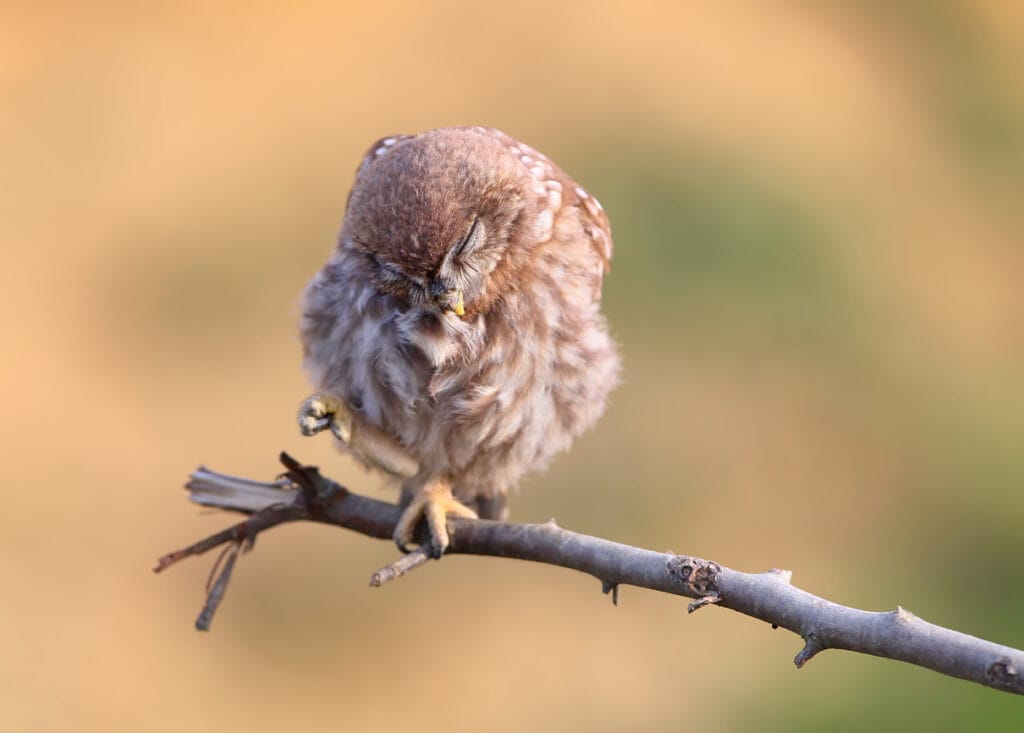
Most bird species sleep standing up, including owls, hawks, and hummingbirds. Owls have special tendons in their legs that keep them clamped against the tree branch they sleep on. That way, they can rest for the night, and at the same time, clamp themselves on the tree for security and to avoid falling.
Other than owls, some birds turn their heads around when sleeping standing up. They tuck their bills into their back feathers. Some species raise one leg up to their belly and fluff their feathers around it to protect them from the cold.
Smaller species, like songbirds, prefer sleeping off the ground for better protection against predatory animals. They usually hide behind foliage and large bushes, so owls and hawks don’t see them either.
What Other Animals Sleep Standing Up?
You wouldn’t believe the number of animals who sleep standing up. Birds aren’t the only creatures around us who can do it; horses, zebras, cows, and elephants do it too.
Author Note: Most four-legged herbivores can sleep standing up, thanks to their joints that lock in place and keep them upright while sleeping. The reason they do it is the same reason birds do it: protection against predators.
Some animals even go into slow-wave sleep like birds to stay on alert during the night. That way, they can run away faster if they need to. The best example of that is horses.
On the other hand, some animals vary between the two positions during the night. Cows, for example, are known to lay down for a while, then stretch and stand up. They also sometimes doze during the day standing up, and it’s mostly out of contentment.
Can Birds Fall Down While Sleeping Standing Up?
The fact that birds can sleep standing up is pretty fascinating, so it’s only natural you start wondering about it. The most obvious question is how birds stay upright without falling down, especially those who perch on thin tree branches.
The answer is anatomy. The birds’ anatomy helps them stay perched all night without falling down. They have two tendons in their legs, otherwise called the flexor tendons. These tendons extend from their leg muscles until their tarsus bone, attaching to their toes.
When the birds land in a perching position, their tendons lock tightly, causing the toes to tighten securely around the tree branch. The reflex is involuntary, meaning it won’t break apart when the bird sleeps.
Some bird species have legs that can do almost anything. They can hop around, walk, and hold onto any object they want. Their anatomy helps them perch onto anything without fear. These species include warblers, sparrows, thrushes, and wrens.
So, to put your mind at ease, birds don’t fall down while sleeping standing up.
Do Birds Open Their Eyes While Sleeping?

The fact that birds sleep standing up is already creepy enough as it is. Do they sleep with their eyes open, too?
Well, not exactly. Birds sometimes sleep with one of their eyes open. Otherwise, they close both eyes.
As you’ve seen, the sleeping behavior of birds is strange in many aspects. It’s totally different from that of other animals and humans. The feathered creatures are capable of sleeping, with only half of their brains resting.
Author Note: They stay partially awake, so they’re ready to flee the scene when a predator comes nearby. That way, they both rest and monitor their surroundings at the same time!
That manner of sleeping is called unihemispheric slow-wave sleep. Nearly all birds living in the wild sleep like that because they’re at a higher risk of predators.
If you have a pet bird, you may not experience this phenomenon. When birds have enough trust in their surroundings, they will close both eyes and rest. If you have another pet they don’t trust enough, they’ll likely keep one eye open.
Closing Thoughts
Everything about birds is unique, starting from their feathered bodies and up to their sleeping habits. There’s no other animal who can sleep perched on a tree branch and with half their brains awake!
What’s even more fascinating is the variety of sleeping positions, according to each species.
The ability to sleep standing may sound abnormal to humans, but it’s a pretty normal occurrence among animals and birds. Their anatomy helps them keep an upright position for an extended time, unlike that of humans.
Plus, their ability to keep their senses alert makes the standing position more convenient. That way, they can defend themselves against any attack.
Fly high friends!
FAQ
If a bird is asleep standing up (or on water), they will often turn their head around and tuck it into their feathers or tuck it down into their breast. They may also fluff their feathers up.
Pretty much from dusk to dawn. However, if it is cold in the morning, they may stay curled up. You might notice this particularly with small birds.
Yes, migrating birds who fly non stop will shut down half of their brain to rest it, while the other half keeps awake to make sure they are safe and on track.




